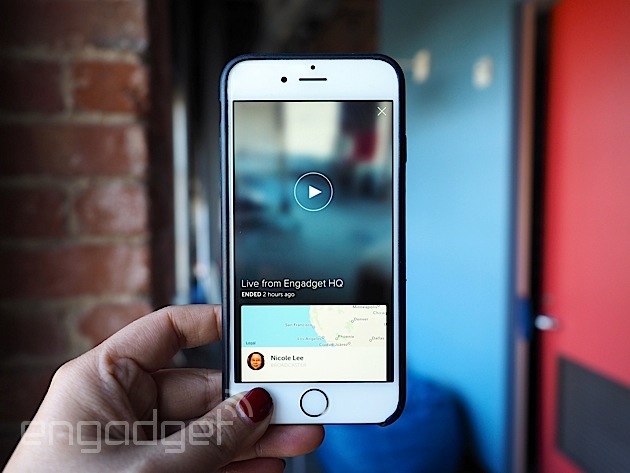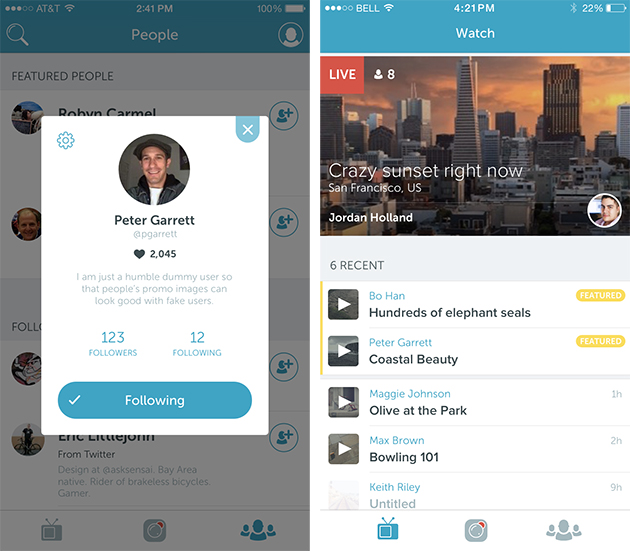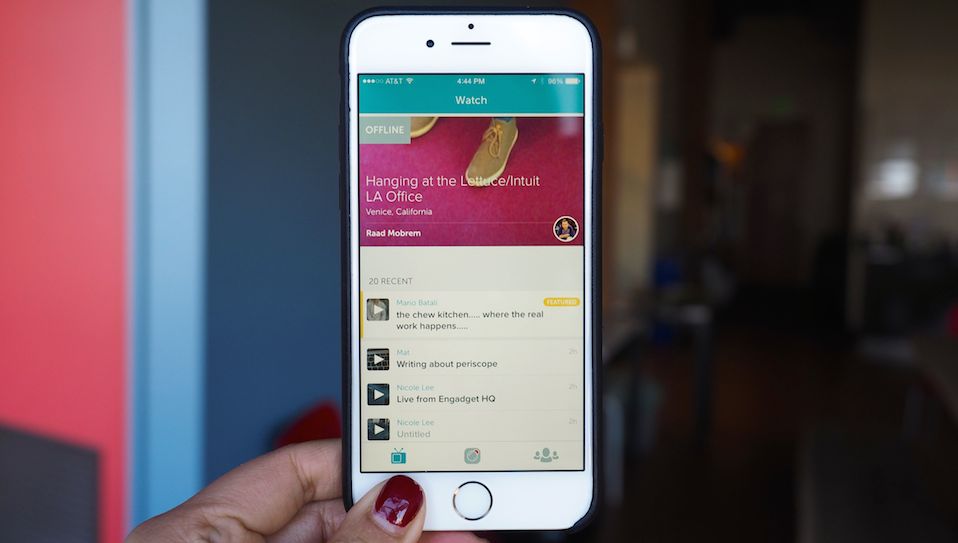The age of ubiquitous livestreaming is upon us. I say this not only because of the sudden popularity of Meerkat, the mobile livestreaming app that now boasts over 100,000 users and celebrity aficionados like Jimmy Fallon and Madonna. No, it's because Meerkat now has a rival. A very big rival, in the form of Twitter. Today, the social media company hastaken the wrapper off Periscope, its very own livestreaming app that it acquired only a couple of weeks ago. Indeed, it was this very purchase that caused Twitter to cut Meerkat from its social graph, a move that makes it a lot harder for those on Meerkat to find folks to follow. Periscope, on the other hand, won't have the same problem -- it automatically suggests people you follow on Twitter when you sign up. That's certainly a significant advantage, but the app needs to be good, too, if it wants to unseat Meerkat. So, is it?
After spending a few days with it, I can say yes, it is. As far as livestreaming apps go, and there aren't very many so far, it's certainly the best I've seen.
But hold on a minute, you might say. What's the purpose behind all this? What's the big fuss with livestreaming at all? Why would I want to watch a live broadcast of someone, especially if that someone is a stranger?
In a week of testing Periscope, I attempted to figure this out. I saw someone attending the Game of Thrones premiere. I saw Dr. Sanjay Gupta perform surgery on the operating table. I saw someone go up in a hot air balloon. I saw a fellow journalist talking to people in an Uber. I saw a friend with his cat. I saw ice melting in a glass of whiskey that apparently belongs to one John Hodgman. For even just a moment, I am allowed a very intimate glimpse into someone else's life. In most cases, those people were eager to talk back.
It was admittedly sort of cool. And a tiny bit addictive.

But wait, I'm getting ahead of myself. Let's go over how the app works. When you launch Periscope, the first thing you'll see is a list of videos. Right up top are broadcasts that are currently live, but if you look underneath that, you'll see a list of recently recorded ones. That's right; unlike Meerkat, which doesn't let you view archives of past livestreams, Periscope lets folks keep their live broadcasts around for later replay. And because Periscope allows me to watch videos hours after the moment has passed, I get to see a lot more of them than I would with something like Meerkat. As for the kind of content you'll see, some of them will be featured videos -- curated stuff that the Periscope team thinks is interesting -- as well as clips that the people you follow have recently broadcasted.
Like with Meerkat, you'll get a push notification whenever someone you follow is broadcasting live and when someone invites you to watch a broadcast. This can get pretty annoying, so I'd suggest tweaking your notification settings to conserve your battery life and your sanity. Once you've decided to view a live broadcast, you can go ahead and watch it like you would on any other livestream service. If you like, you can choose to leave a comment -- the broadcaster and other viewers will see your comment in real time. Unlike Meerkat though, your comments are kept siloed within the app itself, which is great if you dislike cluttering up your Twitter stream with out-of-context remarks. As both a viewer and a broadcaster, you can hide the chat if it gets too noisy, or block someone if they say something offensive.
But perhaps the greatest part of Periscope -- I certainly think it's a highlight -- is the fact that you can send hearts to the broadcaster by tapping on the screen. Each tap will send a heart. Tap the screen multiple times and you'll send a flurry of animated hearts. I'll admit I take more than a little joy out of sending lots and lots of hearts to broadcasters whose videos I like perhaps only a little. On the other end as a broadcaster, it feels oddly gratifying to receive these hearts from viewers. I liken it to getting "favorites" on Twitter or "likes" on Facebook; it taps into that same insecure need for love and recognition (hey, I admit it). It's a very minor feature but it's one that I find rather delightful.

Interestingly, when you watch replays of broadcasts, those comments and hearts will also be replayed, as if you're watching the broadcast live. Kayvon Beykpour, Periscope's co-founder, tells me the idea behind this is intentional. "We try to recreate the experience of having watched it live as much as possible," he says.
Broadcasting on Periscope is a very easy task as well. Simply hit the camera button and give the app permission to access your camera and microphone (which, duh, is necessary). From there, you can choose to enable or disable location sharing. When I ask Beykpour the reason behind adding the location feature, he says that sometimes location is a key point in livestreaming. "Sometimes it's an important attribute. If I see a broadcast in Kiev, covering a Ukrainian protest, that location is very relevant information to what you're showing."
On the other side of the camera, well, I'll be honest. I don't lead a very exciting life. I get up; I go to work; I work all day long; and then I go home. Nobody wants to see that, right? But when I randomly streamed something from the office a few days ago, I was surprised to see so many people join in to say hello. Of course, part of the reason is because the app is so new that there are only so many users around broadcasting in the first place. But it was nice. I almost wish Periscope was around when I was on vacation in Europe a couple of weeks ago, so that I could share my experience walking around Barcelona.

Another interesting feature is that Periscope lets you broadcast privately instead of just to a public audience. You can invite as many people as you want to broadcast to, which Beykpour says is good for sharing intimate moments, like a child's first steps, to family and friends. Also, unlike Meerkat, which auto posts rather obnoxious "|LIVE NOW|" tweets whenever someone is livestreaming on the service, Periscope offers the option to not broadcast that stream on Twitter at all. This way, only Periscope users get to see your stream, which is good if you like separating your social networks.
If that stream does get broadcast on Twitter, however, your followers will see a link to a Periscope web player that lets anyone view your video, not just those with the app (though those without the app will likely get a prompt to download it). That said, web viewers aren't able to leave comments or send hearts or watch the archives, so those keen on interaction will probably still want to get it.
Once you've got the livestream going, you can double-tap the screen to flip the cameras from rear-facing to front-facing (and vice versa) and swipe down to reveal the Stop Broadcast button. After you stop the broadcast, the video will automatically be saved for replay and you can then choose to save it to your camera roll if you like. But let's say you found something kinda embarrassing and you'd rather not have anyone view that video ever again. No worries, because if you scroll down to the bottom, you can select the option to delete that footage. You can even opt to share the video but hide the comments entirely.

Beykpour tells me that an infinite number of people can view any one broadcast, which sounds pretty crazy to me, especially if you consider that someone like Beyoncé might livestream a video and get millions and millions of viewers. Imagine if all those people left a comment at once! That's why Periscope apparently has some heuristics in place to prevent such chaos if it does happen. "For example, after a certain scale, only people the broadcaster follows can chat," he says. "But that'll be a very rare occasion."
Also, there is no maximum length that you can broadcast -- you can record for however long you desire. Of course, your iPhone might not have enough storage space for the video to save to your camera roll, but the video will carry on livestreaming as long as you have battery life and a decent internet connection.
Still, there are some serious questions about livestreaming that need to be answered, especially around privacy. When I'm livestreaming on my phone, there's nothing to indicate that I'm doing it except for maybe the unusual posture of holding it. The Starbucks barista who made my coffee didn't know he was being livestreamed. The lady walking the dog next to me on the sidewalk didn't know she was being livestreamed. Of course, the photos you post on Instagram and the videos you post on Vine are subject to the same concerns, but there's something so immediate and right-now about livestreaming that makes the issue more real.
Beykpour chooses to see the positive side of it. "Livestreaming was the best way to accomplish what we wanted to do, which was to give you the sense of what's happening in the world right now," he says. "Live video is interactive. It's a much more compelling medium. ... It's literally stepping into someone else's shoes."
Beykpour chooses to see the positive side of it. "Livestreaming was the best way to accomplish what we wanted to do, which was to give you the sense of what's happening in the world right now," he says. "Live video is interactive. It's a much more compelling medium. ... It's literally stepping into someone else's shoes."

As for Meerkat, Beykpour says that it's not a big deal that his app has debuted several weeks after the competition. "We were never going to be the first to market -- Ustream and Justin.tv existed before," he says. "We believe that Periscope is charming and endearing and it's something that people will love to use." He adds that Periscope is not just for celebrities; it could also be about sharing civic unrest like what's happening in Ferguson or it could be about sharing intimate moments with family. "Periscope enables that which no other platform has done before."
Ben Rubin, Meerkat's CEO and co-founder, says that he finds Periscope to be a pretty sleek app and doesn't think of it in a negative light. "It means good things for livestreaming," he says. "We don't look at it as a rivalry. We just have a different approach." If anything, he adds, Periscope will spread the word of livestreaming even more than before, which is good for Meerkat too.
Of course, Periscope is still very much in development. There's currently no support for landscape mode and you're not able to type in the comments section yourself -- the idea is that you're supposed to speak to your viewers, not just type at them -- but the team is working very hard on improving things, and we'll likely see lots of updates in the coming weeks and months.
For now, however, you can satisfy your livestreaming curiosity by downloading the app. It's iOS-only for now, but word is that an Android version is on its way very soon.






